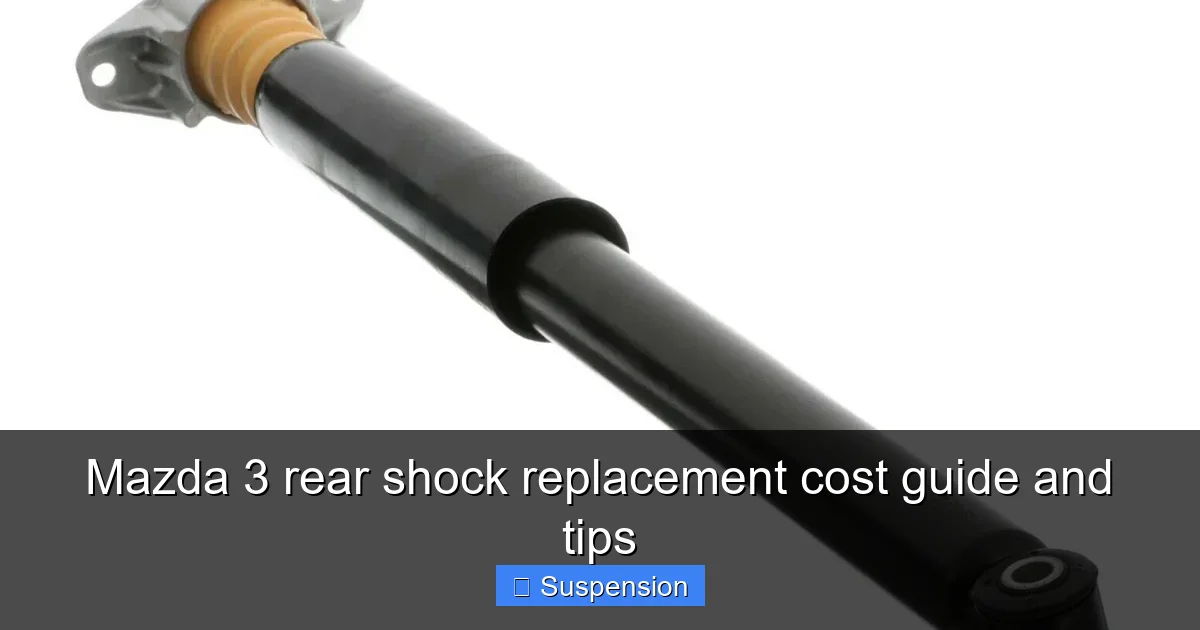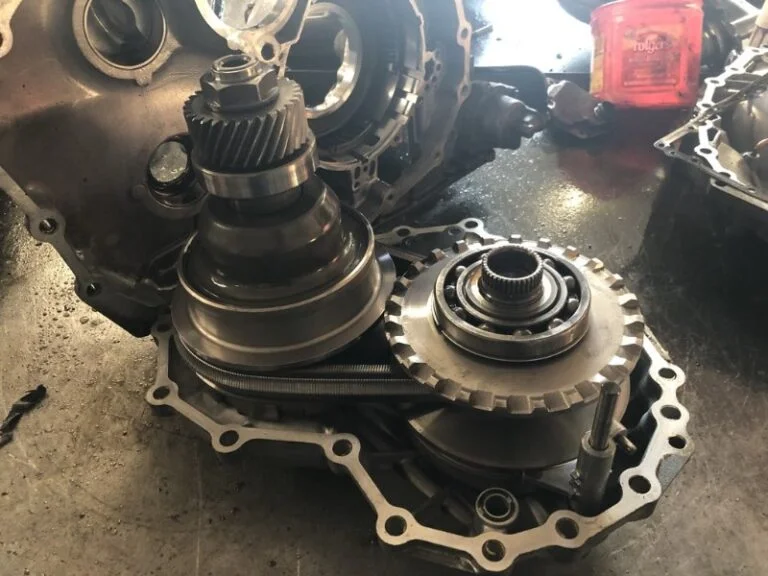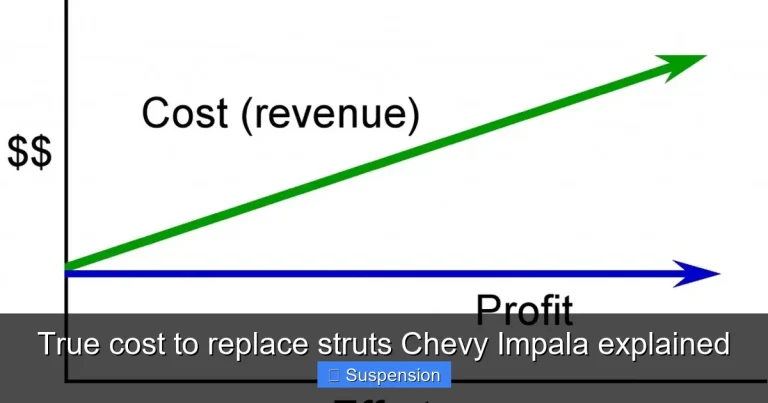Mazda 3 rear shock replacement cost guide and tips
Mazda 3 rear shock replacement typically costs between $250 and $600, depending on your model year, parts quality, and local labor rates. Understanding what affects the price—OEM vs. aftermarket shocks, doing both sides at once, and shop fees—helps you budget accurately and decide whether a DIY job or professional installation offers the best value and ride comfort for your Mazda 3.
Mazda 3 rear shock replacement cost guide and tips
If your Mazda 3 has started to feel bouncy, floaty, or just “off” over bumps, you’re not imagining it. Rear shocks wear out slowly, so the change is easy to miss until the ride gets pretty bad. At some point, you’ll have to face the big question: what is the Mazda 3 rear shock replacement cost, and is it worth doing now?
I’ve been through this same decision with compact cars like the Mazda 3, and it always comes down to a mix of budget, safety, and comfort. The good news is that rear shocks are usually cheaper and easier to replace than many other suspension parts. The tricky part is knowing what’s a fair price, what parts to choose, and whether you can delay the job or not.
In this guide, I’ll walk you through typical Mazda 3 rear shock replacement cost ranges, what affects the price, and how to save money without cutting corners. I’ll also share some simple tips that can help you decide when it’s really time to replace your rear shocks.
Key Takeaways
- Expect typical costs: Mazda 3 rear shock replacement usually ranges from $250–$600 for both sides.
- Parts vs labor: Parts average $120–$300, while labor often runs $130–$300 depending on shop rates.
- Replace shocks in pairs: Always change both rear shocks together to maintain balanced handling and tire wear.
- Watch for warning signs: Excessive bouncing, clunking, or uneven tire wear signal it’s time to replace shocks.
- Compare shop quotes: Get multiple estimates, checking for itemized parts, labor, and warranty coverage.
- Consider OEM vs aftermarket: OEM offers factory feel; quality aftermarket can be cheaper without sacrificing safety.
- Plan for alignment check: After rear shock replacement, confirm alignment and suspension components are inspected.
Quick Answers to Common Questions
How much does Mazda 3 rear shock replacement cost on average?
The Mazda 3 rear shock replacement cost typically ranges from $250 to $500 for both rear shocks, including parts and labor, depending on your location and shop rates.
Is it necessary to replace both rear shocks on a Mazda 3 at the same time?
Yes, it’s strongly recommended to replace both rear shocks together, as uneven damping can affect handling and may increase the overall Mazda 3 rear shock replacement cost later.
How do labor charges affect Mazda 3 rear shock replacement cost?
Labor usually makes up about half of the Mazda 3 rear shock replacement cost, with shops typically charging 1–2 hours of labor for the job.
Can I use aftermarket parts to lower my Mazda 3 rear shock replacement cost?
Yes, quality aftermarket shocks can reduce your Mazda 3 rear shock replacement cost compared to OEM parts, as long as you choose reputable brands.
How often should I budget for Mazda 3 rear shock replacement cost?
Most drivers won’t face a Mazda 3 rear shock replacement cost until around 60,000–100,000 miles, though rough roads and heavy loads can shorten that interval.
📑 Table of Contents
How much does Mazda 3 rear shock replacement cost?
Average cost range you can expect
For most owners, the Mazda 3 rear shock replacement cost for both rear shocks together usually falls in this range:
- Parts (both rear shocks): $120 – $350
- Labor: $120 – $260
- Total (both rears): about $240 – $610
This is a typical range for many Mazda 3 model years, including older models and newer ones. Exact pricing will change by region, shop type, and the brand of shocks you choose.
Dealer vs independent shop vs DIY
Where you go has a big impact on the Mazda 3 rear shock replacement cost:
- Mazda dealership: Often the highest cost. Expect something like $450 – $700 for both rear shocks with OEM parts. You pay more for brand parts and dealer labor rates.
- Independent mechanic: Usually the best balance. Many shops land around $280 – $550 for the rear pair, depending on parts quality and your area.
- DIY in your garage: If you have tools and some experience, your cost can drop to the price of parts only, maybe $120 – $350. But you trade money for time, effort, and some risk.
Prices also shift between regions. A big city shop with high overhead will charge more than a small town garage. That is why getting at least two or three quotes is smart before you commit.
Quick comparison table
| Option | Estimated Parts Cost (pair) | Estimated Labor Cost | Typical Total (pair of rear shocks) | Pros | Cons |
|---|---|---|---|---|---|
| Mazda dealership | $200 – $350 | $200 – $350 | $450 – $700 | OEM parts, brand backing, factory procedures | Highest Mazda 3 rear shock replacement cost |
| Independent shop | $120 – $280 | $120 – $270 | $280 – $550 | Better value, more parts choices | Quality varies by shop |
| DIY at home | $120 – $350 | $0 | $120 – $350 | Lowest out-of-pocket cost | Needs tools, time, and some skill |
What affects Mazda 3 rear shock replacement cost?
1. Model year and trim of your Mazda 3
Not all Mazda 3 shocks are priced the same. The Mazda 3 rear shock replacement cost changes with year and setup:

Visual guide about mazda 3 rear shock replacement cost
Image source: down-ph.img.susercontent.com
- Older models (early 2000s): Parts are often cheaper and widely available. Labor is similar, but some rust can slow the job down.
- Newer models: Shocks might cost more, especially if they are a newer design or sport-tuned from the factory.
- Sport or performance trims: If your Mazda 3 has a sport package or a firmer suspension, shocks may be more expensive, especially if you stick with OEM or performance brands.
When you call shops for quotes, have your exact year, trim, and VIN ready. That way they price the correct part and you get a realistic Mazda 3 rear shock replacement cost.
2. OEM vs aftermarket shocks
This is one of the biggest choices you will make. It changes both the cost and how the car feels.
- OEM shocks (Mazda-branded): These match what the car had from the factory. Ride and handling will feel familiar. They tend to be more expensive but are a safe choice.
- Aftermarket shocks: Brands like KYB, Monroe, Bilstein, and others offer options from basic to performance. Many are cheaper than OEM while still very good quality.
If you want to keep the original feel, OEM or OEM-equivalent aftermarket shocks are ideal. If you want a slightly firmer ride with better control, a mild performance shock might suit you better. Just remember that high-end shocks can also increase the Mazda 3 rear shock replacement cost.
3. Labor time and shop rates
Rear shocks on many Mazda 3 models are not the hardest job, but a few things change the labor side:
- Rust and corrosion: In areas with lots of road salt, bolts can seize. That can add time and labor cost.
- Extra parts replacement: If shock mounts, bump stops, or hardware are worn, the mechanic may suggest replacing them at the same time.
- Shop hourly rate: A shop at $80/hour vs $150/hour will change your final Mazda 3 rear shock replacement cost even if the job time is the same.
Most shops will quote 1–2 hours of labor for both rear shocks, depending on the exact setup and condition of your car.
4. Extra services done at the same time
Rear shock replacement can be a good time to tackle other items, but those will add to the bill:
- Wheel alignment (if recommended)
- Rear suspension bushings or links
- Front shocks or struts if they are also worn
Doing everything at once can save some labor later, but it does push up the immediate Mazda 3 rear shock replacement cost. Ask the shop to separate the quote so you can see what is essential and what is optional.
Signs your Mazda 3 rear shocks need replacement
Ride and handling changes
Most people notice worn rear shocks through how the car feels. Some common signs include:
- Excessive bouncing: Go over a speed bump and see how many times the rear bounces. More than one or two times is a red flag.
- Floaty or unstable feel: On the highway, the rear may feel like it is drifting or swaying slightly, especially in crosswinds.
- Harsh impact over bumps: Instead of a controlled “thud,” you get a sharp, jarring hit that feels rough.
These changes build up slowly. It is easy to adapt and not notice until the shocks are very tired. That is why many people are surprised the first time they feel the car with fresh shocks.
Visible wear and leaks
You can also do a quick visual check. Safely park the car, set the brake, and look behind the rear wheels:
- Oil on the shock body: If the shock is wet or oily, it is leaking and should be replaced.
- Damaged boots or bump stops: Cracked or missing rubber parts allow dirt and moisture in, which speeds up wear.
- Uneven ride height: If one rear corner sits lower, you may have a spring or shock issue.
Any of these signs suggest it is time to think about the Mazda 3 rear shock replacement cost and plan the repair.
Impact on safety and tires
Worn rear shocks are not just annoying. They can affect safety and long-term costs:
- Longer stopping distance: The tires may not stay planted under hard braking, especially on rough roads.
- Poor grip in corners: The rear of the car may step out more easily, especially in the rain.
- Uneven tire wear: Bouncing and hopping can create cupped or scalloped tire wear, which gets noisy and shortens tire life.
So while the Mazda 3 rear shock replacement cost might feel like a hit now, it can prevent bigger costs in tires and help keep the car predictable in an emergency.
Ways to save on Mazda 3 rear shock replacement cost
Compare quotes and ask for options
Do not stop at the first number you hear. A little shopping around can make a big difference in your Mazda 3 rear shock replacement cost:
- Call at least two or three shops with the same details (year, trim, and whether you want OEM or aftermarket).
- Ask for a line-item quote that separates parts and labor.
- Ask if they have good-quality aftermarket options that might cost less than OEM.
Be clear that you care about safety and quality, not just the lowest price. Most honest shops will work with you to find a fair solution.
Choose parts that match your driving
Picking the right shock can keep your Mazda 3 rear shock replacement cost in check and still give you a ride you like:
- Mostly city and highway driving: A mid-range aftermarket shock is often perfect. It saves money and rides well.
- Spirited or performance driving: A sportier shock will cost more but can improve handling and control.
- Long-term ownership: Spending a bit more on a durable brand might pay off if you plan to keep the car for many years.
There is no single “best” choice. It is about what matters to you: comfort, handling, or budget. A good shop can explain the pros and cons of each option in plain language.
Bundle work when it makes sense
Sometimes you can reduce long-term costs by doing related work together:
- If your front struts are also worn, changing all four corners at once can save time and labor over doing them in separate visits.
- If the shock mounts or hardware are rusty or worn, replacing them now can prevent another labor charge later.
- If a shop offers a discount for multiple services (like brakes and shocks together), ask if it applies.
This might increase the immediate Mazda 3 rear shock replacement cost, but it can lower the total you spend over the next few years.
Consider DIY only if you are prepared
If you are handy and have tools, doing the job yourself can cut the Mazda 3 rear shock replacement cost down to just parts. But be realistic:
- You will need jack stands, a jack, and hand tools at a minimum.
- You must be comfortable working under the car safely.
- You should have a repair manual or step-by-step guide for your exact Mazda 3 model.
Rear shocks are usually easier than front struts, but they still require care. If you are not sure, it is better to pay a pro and know the job is done right.
What to expect during and after replacement
The basic replacement process
Here is a simple overview of what happens when a shop replaces your rear shocks:
- They confirm the correct parts for your Mazda 3 and inspect the rear suspension.
- The car is lifted and the rear wheels are removed.
- The old shocks are unbolted from the lower and upper mounts.
- New shocks are installed with fresh hardware if needed and torqued to spec.
- The mechanic checks for any other issues and then test-drives the car.
For many Mazda 3 models, this is a straightforward job, which is why the labor part of the Mazda 3 rear shock replacement cost is not as high as some other repairs.
Do you need an alignment after rear shocks?
This is a common question. In many cases, replacing only the rear shocks does not require an alignment, because you are not changing adjustable components like control arms or tie rods.
However, an alignment can still be a good idea if:
- You have not had one in a long time.
- You also replaced front struts or other suspension parts.
- Your tires show uneven wear or the car pulls to one side.
An alignment adds to your Mazda 3 rear shock replacement cost, but it can extend tire life and improve handling. Ask the shop if they see any signs that an alignment would help.
How your Mazda 3 should feel after new shocks
Once the new shocks are in, you should notice a clear difference, especially if the old ones were very worn:
- The rear will feel more planted and stable over bumps.
- Bouncing after speed bumps or dips should be much reduced.
- On the highway, the car should feel more controlled and less floaty.
Some shocks may feel a bit firm at first and then settle in over a few hundred miles. If anything feels wrong, like clunks, rattles, or strange noises, go back to the shop and have them recheck the work.
Is Mazda 3 rear shock replacement worth the cost?
Balancing cost, comfort, and safety
When you look at the Mazda 3 rear shock replacement cost, it can be tempting to delay. But there are a few points to keep in mind:
- Good shocks help your tires grip the road, which matters in wet or emergency situations.
- They protect other suspension parts by keeping movement under control.
- They make the car less tiring to drive, especially on longer trips.
If your rear shocks are leaking or clearly worn out, replacing them is not just a comfort upgrade. It is part of keeping the car safe and predictable.
Thinking long-term about your Mazda 3
If you plan to keep your Mazda 3 for several more years, investing in new shocks is usually a smart move. Even at the higher end of the Mazda 3 rear shock replacement cost range, you are spreading that expense over many miles of better ride and handling.
On the other hand, if you are about to sell the car and the shocks are only slightly worn, you might choose to delay. Just be honest with yourself about how the car feels and whether it still behaves the way you need it to.
Final thoughts
The Mazda 3 rear shock replacement cost may sound like just another bill, but it is one of those repairs that you can feel every time you drive. With a bit of research, a few quotes, and the right choice of parts, you can keep your Mazda 3 riding smooth and safe without overspending.
Take a short test drive on a road with some bumps, pay attention to how the rear feels, and then decide your next move. If your shocks are due, think of the cost as an investment in comfort, control, and peace of mind every time you get behind the wheel.
Frequently Asked Questions
How much does a Mazda 3 rear shock replacement cost on average?
The average Mazda 3 rear shock replacement cost typically ranges from $250 to $550 for both rear shocks, including parts and labor. Prices vary based on your location, the shop’s labor rate, and whether you choose OEM or aftermarket parts.
What factors affect Mazda 3 rear shock replacement cost?
The main factors are the type of shocks (OEM vs aftermarket), labor rates in your area, and whether additional components like mounts or bump stops need replacement. Dealerships usually charge more than independent shops, and performance shocks will also increase the total cost.
Should I replace both rear shocks on my Mazda 3 at the same time?
Yes, it’s strongly recommended to replace both rear shocks together to maintain balanced handling and even tire wear. Replacing only one can lead to uneven suspension performance and may cause premature wear on other suspension components.
How do I know if my Mazda 3 rear shocks need to be replaced?
Common signs include a bouncy or unstable ride, clunking noises over bumps, uneven tire wear, or the rear of the car sagging or bottoming out. You might also notice longer braking distances or the car swaying more than usual when cornering.
Can I drive my Mazda 3 with bad rear shocks, and is it safe?
You can often still drive with worn rear shocks, but it’s not ideal or fully safe. Compromised shocks reduce stability, braking performance, and overall control, especially in emergency maneuvers or bad weather, so replacement should not be delayed.
Can I replace Mazda 3 rear shocks myself to save on cost?
Many DIY enthusiasts can replace Mazda 3 rear shocks with basic tools and a good repair guide, saving on labor costs. However, if you’re not comfortable working with suspension components or lack proper tools and jack stands, it’s safer to have a professional do the job.







